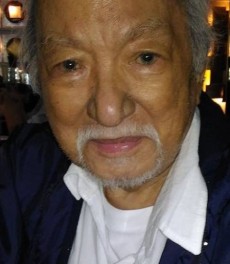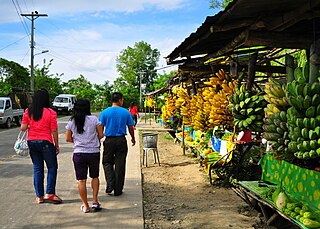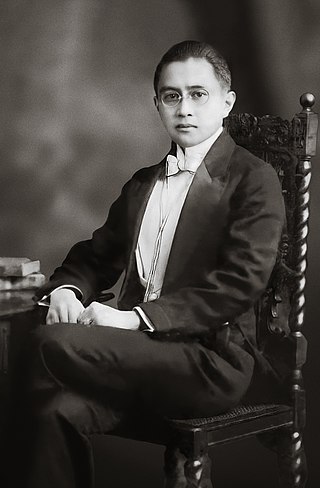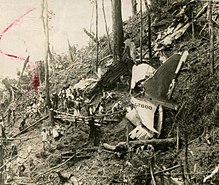
Ramon del Fierro Magsaysay was a Filipino statesman who served as the seventh President of the Philippines, from December 30, 1953, until his death in an aircraft disaster on March 17, 1957. An automobile mechanic by profession, Magsaysay was appointed military governor of Zambales after his outstanding service as a guerrilla leader during the Pacific War. He then served two terms as Liberal Party congressman for Zambales's at-large district before being appointed Secretary of National Defense by President Elpidio Quirino. He was elected president under the banner of the Nacionalista Party. He was the youngest to be elected as president, and second youngest to be president. He was the first Philippine president born in the 20th century and the first to be born after the Spanish colonial era.

Mount Pinatubo is an active stratovolcano in the Zambales Mountains, located on the tripoint boundary of the Philippine provinces of Zambales, Tarlac and Pampanga, all in Central Luzon on the northern island of Luzon. Its eruptive history was unknown to most before the pre-eruption volcanic activity of early 1991. Pinatubo was heavily eroded and obscured from view by dense forests which supported a population of several thousand indigenous Aetas.

Sergio Osmeña Sr. was a Filipino lawyer and politician who served as the fourth President of the Philippines from 1944 to 1946. He was Vice President under Manuel L. Quezon. Upon Quezon's sudden death in 1944, Osmeña succeeded him at age 65, becoming the oldest person to assume the Philippine presidency until Rodrigo Duterte took office in 2016 at age 71. A founder of the Nacionalista Party, Osmeña was also the first Visayan to become president.

Carlos Polestico Garcia, often referred to by his initials CPG, was a Filipino teacher, poet, orator, lawyer, public official, political economist, guerrilla and Commonwealth military leader who was the eighth President of the Philippines. A lawyer by profession, Garcia entered politics when he became representative of Bohol’s 3rd district in the House of Representatives. He then served as a senator from 1945 to 1953. In 1953 he was the running mate of Ramon Magsaysay in the 1953 presidential election. He then served as vice president from 1953 to 1957. After the death of Magsaysay in March 1957, he succeeded to the presidency. He won a full term in the 1957 presidential election. He ran for a second full term as president in the 1961 presidential election and was defeated by Vice President Diosdado Macapagal.

Nestor Mata was a Filipino journalist whose writing career spanned six decades. He was also known as the only survivor of the 1957 plane crash that killed the President of the Philippines, and 25 others.

Balamban, officially the Municipality of Balamban, is a 1st class municipality in the province of Cebu, Philippines. According to the 2020 census, it has a population of 95,136 people.

Don Gabriel Amando Daza, KGCR, KC*SS was the first Filipino electrical engineer and one of the charter members of the Boy Scouts of the Philippines (BSP). He co-founded the Philippine Long Distance Telephone Company (PLDT), Philippine Telegraph and Telephone Co. (PT&T), Philippine Electric Manufacturing Company (PEMCO), Phelps Dodge Philippines. He was the supervising engineer and assistant general manager of Visayan Electric Company (VECO) and led its expansion out of Cebu City. President and chief scout of the BSP in 1961–68. In 1945, President Osmeña appointed Daza to be a member of the board of directors of the Manila Railroad Company and the Philippine Charity Sweepstakes Office. In 1950, he was vice-chairman of the National Power Corporation and on the board of directors of the Manila Hotel Company. In 1951, Daza was appointed by President Quirino as a founding member of the board of directors of the National Shipyard and Steel Corporation. President and director of the National Economic Protection Agency (NEPA) in 1956.

Luz Rosauro-Magsaysay was the wife of Philippine President Ramon Magsaysay and the seventh First Lady of the Philippines.

This article covers the history of the Philippines from the recognition of independence in 1946 to the end of the presidency of Diosdado Macapagal that covered much of the Third Republic of the Philippines, which ended on January 17, 1973, with the ratification of the 1973 Constitution of the Republic of the Philippines.

Tomás Lluisma Cabili was a Filipino lawyer, journalist, educator, and assemblyman from Lanao. He was also known as "Sultan Dimasangkay-ko-Ranao" for Maranaos.

Philippine Airlines Flight 206 (PR206) was the route designator of a domestic flight from Manila Domestic Airport, Metro Manila, Philippines, to Loakan Airport, Baguio. On June 26, 1987, the Hawker Siddeley HS 748 crashed onto a mountain en route to Baguio, killing all 50 people on board.
The crash of a bus in Balamban, Cebu, Philippines, killed at least 21 people and another 26 were wounded on 13 June 2010.
Mount Manunggal is the third-highest peak in the island of Cebu after Osmena Peak and Lugsangan Peak. It is located in Barangay Magsaysay in Balamban, Cebu province, rising 982 m (3,222 ft) above sea level. It is the site of the crash of the presidential plane Mt. Pinatubo that killed President Ramon Magsaysay and 24 others on March 17, 1957.

The inauguration of Carlos P. Garcia as the eighth president of the Philippines took place at 5:56 PM (PHT) on Sunday, March 18, 1957 at the Council of State Room of Malacañang Palace in Manila, following the death of President Ramon Magsaysay in a plane crash a day earlier. The third non-scheduled extraordinary inauguration marked the commencement of the first term of Garcia as President. Chief Justice Ricardo Paras of the Supreme Court administered the oath of office. Garcia flew earlier that day to Manila from Australia, where he was leading the Philippine delegation to the SEATO conference then being held in Canberra when he learned of Magsaysay's tragic death.
The Philippine presidential line of succession defines who becomes or acts as president upon the incapacity, death, resignation, or removal from office of a sitting president or a president-elect.

Of the seventeen presidents of the Philippines, a number have shown proficiency in languages other than English and Tagalog.
Pedro T. Lopez was a Filipino Visayan lawyer, writer, and legislator from Cebu, Philippines. He founded the Cebuano periodical Nasud (Nation), elected as Congressman during the 1st Congress of the Commonwealth in 1945, and member of the 3rd Congress of the Republic for Cebu's 2nd district. In 1946, he was appointed to the Philippine Rehabilitation Commission, delegate to the first United Nations General Assembly, and associate prosecutor International Military Tribunal for the Far East.

Philippine Air Lines Flight S85 was a domestic flight that crashed shortly after taking off from Cebu-Lahug Airport, Cebu.















